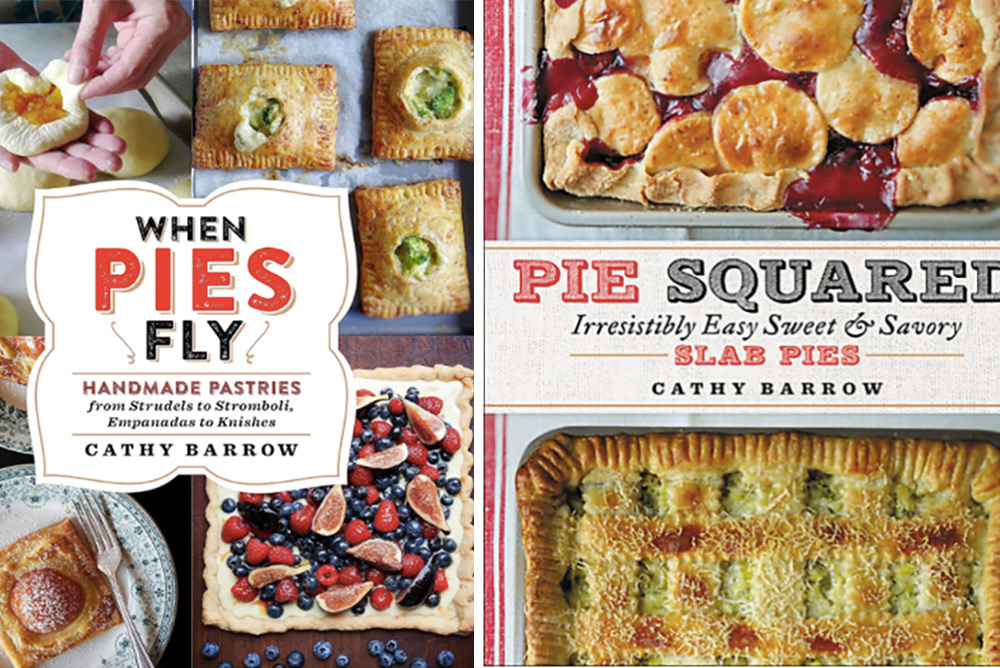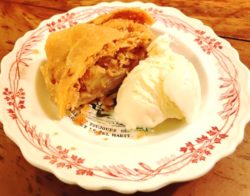
Cathy Barrow’s books started Nancy Pollard on a spate of pastry baking, including strudel. / Photos on the front: Christopher Hirsheimer (food photos) and Julia Rochelle (author portrait).
After owning one of the best cooking stores in the US for 47 years—La Cuisine: the Cook’s Resource, in Alexandria, Virginia—Nancy Pollard now writes Kitchen Detail, a blog about food in all its aspects—recipes, film, books, travel, superior sources and food-related issues. She and her husband, the Resident Wine Maniac, have recently moved to Italy.
READING through her cookbooks, you can envision the landscape-design skills Cathy brings to the counter, including laying out pastry parameters with a ruler and painter tape and precisely calibrating the filling of different pie forms so that there is no gooey spillage. Not to mention the imaginative use of pastry cutouts. Long before this volume, Cathy used her cooking expertise to create not only a website but also classes in her home around the craft of preserving everything from peaches to pastrami. This led to publishing a most thorough tome on preserving, Mrs. Wheelbarrow’s Practical Pantry, followed by writing instructive food columns for both The New York Times and The Washington Post. When Cathy felt that she had written all that she could about preserving, she was given the opportunity to develop recipes for something portable that could feed a crowd . . . slab pies. After the success of Pie Squared, Cathy’s inventive pastry mind envisioned how you could take a free-form pastry envelope to another level. Hence she produced this very precise and yet imaginative book on pastries without a baking form—galettes, empanadas, knishes, hand pies, and, yes, strudel—When Pies Fly.
Strudel Skirmishes
We’re not talking the faux strudel using filo sheets (that has its place, but it ain’t the real thing). I had struggled with strudel for years and had a distracted hiatus during my daughters’ adolescence. There were some vague American baking books on strudel and some very humorless German cookbooks, and I did have a couple of successful outcomes. But nothing like when I completed a strudel following directions from When Pies Fly. The section on strudel is short, but the directions, recipes, and the thoughtful coaching from Cathy made this delicious, and for me nostalgic, treat actually almost easy. It is a project, though. Best to make the dough, which is a snap, the night before. The 100 slaps on the counter was great (view it as an extension of Orange Theory Fitness). Then, the next day prep your filling. Find a tablecloth (not vinyl) or very large kitchen towel (not terry) that may have seen better days, flour it as directed and then read through the instructions several times and look at Carol’s photos. Things really do come together as written. I also looked at some Austrian videos and enjoyed the variations. Sometimes the stretched dough was painted with melted butter before laying in the filling. In a few, the filling is spread across the dough and then rolled. I was entranced with one baker, who had a dry filling of sliced apples, sugar and cinnamon, with a touch of rum sprinkled over, and then he took a siphon of Schlag (whipped cream to us) and ran a healthy dose down the center of the filling! Apparently the cream bakes into the apples and moistens them a bit. I am definitely going to try this next!
Pulled Dough for Strudel

- 1½ cups (150gr) all-purpose flour
- ½ teaspoon fine salt
- 3 tablespoons sunflower or grapeseed oil
- 1/3 cup (80ml) cool water
- In a wide bowl, using a table fork, stir together the flour and salt.
- Make a well in the center and pour in the oil. Gather the flour into the oil with the fork.
- Pour the water slowly over the mixture, using the fork to incorporate the two. Dough will appear somewhat shaggy and wet.
- Lightly flour your hands and, working inside the bowl, gather the dough, lifting, turning, folding until the dough is silky and smooth. This process takes about five minutes.
- On a lightly floured surface, slap the dough down and pull it up 100 times.
- Lightly coat the dough with oil (or oil inside a ziptop bag) and place the dough in the bag. Seal it and refrigerate overnight. (Cathy advises that this dough cannot be frozen, but can be refrigerated for two days.)
- The dough needs to be at room temperature before the next step.
- On a table or counter area, spread a cloth towel. Sprinkle and rub flour into the cloth with the heel of your hand.
- Lay the dough in the center of the cloth and get some flour on each side. You can lift and turn the dough to give it a bit of a stretch.
- Gently roll the dough into a 10-inch square.
- Using the backs of your hands, lift the dough and, turning, allow it to stretch gradually into a rough rectangle.
- You will have to move around the table if you don’t have a partner in strudel pulling.
- Once it gets close to its goal size of around 20×24 inches (Cathy says you can start this next step at about 16 inches square), you can stretch the dough, placing one hand on the surface and working with your knuckles on the underside. You should be able to see through to the cloth when you reach a bit over 20×24 inches.
- Stretch the thickened edges around the perimeter.
- Trim the edges with scissors.
- If your filling is ready, place it along the short edge, leaving about 2 inches on each side.
- Fold the long edges over the filling and then, using your cloth, roll the strudel gently but firmly.
- Tip the strudel log onto your baking sheet (I used Silpat, but parchment is fine), seam side down.
- Baste the log with melted butter and pop it into the preheated oven.
- Bake for about 20 to 25 minutes. You are looking for a pale gold crust, not deep tan.
Spiced Apple Filling for Strudel

- 4 tablespoons (55gr) unsalted butter
- ½ cup (60gr) dry bread crumbs
- ½ cup (43gr) sliced almonds
- Juice of 1 lemon
- 1½ pounds (660gr) firm apples (Granny Smith, Pink Lady or Pink Pearl are suggestions)
- ¾ cup (150gr) granulated sugar
- 3 tablespoons (45ml) spiced dark rum
- 1 teaspoon ground cinnamon
- ¼ teaspoon freshly grated nutmeg
- 3 tablespoons (42gr) melted unsalted butter
- Powdered sugar
- Preheat oven to 400F. Line a rimmed baking sheet with parchment.
- In a large skillet, melt 4 tablespoons of butter over medium heat and add the bread crumbs, turning them until they absorb the butter and are golden.
- Transfer the crumbs to a bowl and wipe out the pan.
- Toast the almonds in the same pan, shaking them regularly, until golden and scented, about 3 to 4 minutes. Stir the almonds into the bread crumbs.
- Juice the lemon into a large bowl. Peel and halve the apples, removing the cores. Slice into half-moon shapes no more than 1/8 inch thick. Add the apples to the bowl of juice, mixing thoroughly as this will keep the apples from turning brown.
- Add ½ cup of the sugar, the rum, cinnamon and nutmeg to the apples, stirring gently together. Set aside.
- After you lay your prepared dough in place, spread the crumb-almond mixture across the dough but leave a 2-inch border on all sides. Sprinkle the remaining sugar across the crumb mixture.
- Retain the liquid from the apple-juice mixture. Shape the apple filling into a log about 2 inches from the shorter edge.
- Using your cloth as the driver, start rolling and lifting the dough, starting with the 2-inch border. Fold in the long sides, and continue to roll the strudel using the cloth.
- At the end you should have a fairly tight, uniform roll. You can prod it into shape gently.
- Transfer to the baking sheet, seam side down, brush with the melted butter and bake for 20 to 25 minutes.
- Once the strudel is cool, you can generously dredge the surface with powdered sugar.
This post originally appeared in Kitchen Detail.



